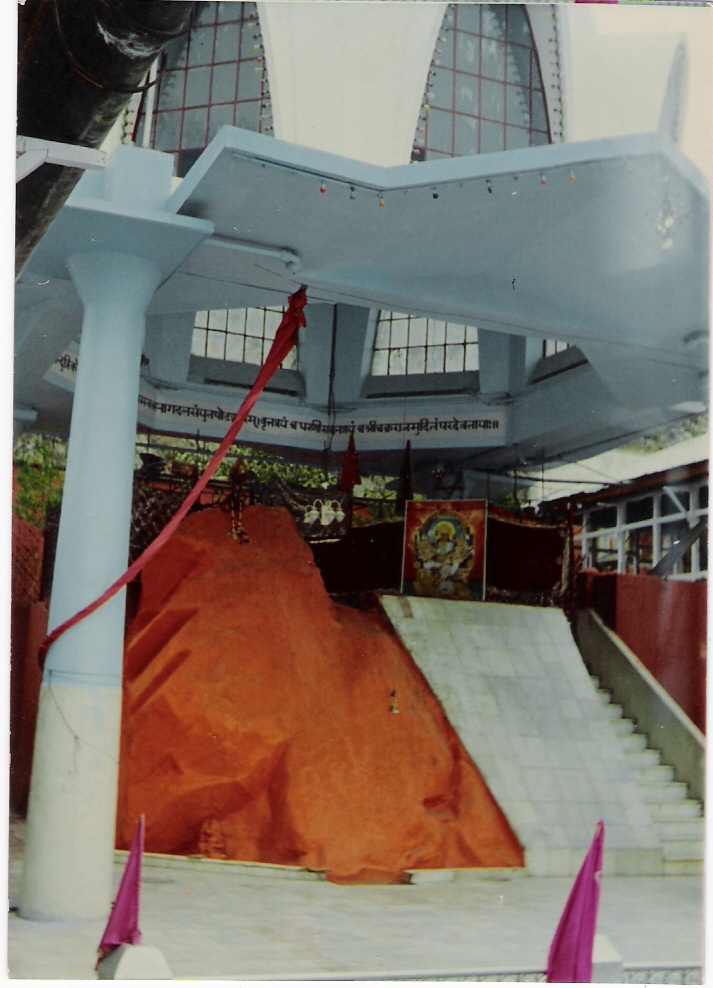Chakrishor, Srinagar
by Chander M. Bhat
Hari
Parbat (Sharika Peeth) is situated at the periphery
of Srinagar city is an ancient and one of the
holiest places of Kashmir and is associated with the
Kashmir Culture since time immemorial. It is the
abode of Maha Shakti. The Divine Mother of Shri
Jagat Amaba Sharika Bhagawati also known as Maha
Tripursundhari or Rajeshwari locally called as Harie.
The Eighteen armed Goddess Sharika is regarded as
the presidisng deity of Srinagar city.
The
Goddess Sharika is represented by a Sayambhu ‘Sri
Chakra’ also called ‘Maha Sriyantara’ which
consists of circular Mystic impressions and
triangular patterns with as
dot (Bindu)
at the centre. The myustic Sri Chakra self engraved
on a vertical rock (Shilla)
is located at the middle of western face of
Hariparbat (Hillock).

Chakrishor
Temple
There
is a legend, which talks of how the hill got its
name. It is said that after Kashyapa Rishi drained off the water of the Satisar, a remnant lake was still there in the vicinity of Hari
Parvat. A demon by the name tsand,
who took shelter in this lake, troubled the
inhabitants in and around the area. Desperate, the
inhabitants prayed to goddess Durga and sought her
protection. In order to protect them, she took the
form of a bird, called heuur
in Kashmiri, who picked up a pebble in her beak and
dropped it over the lake trapping the demon inside.
The pebble grew in size to that of the Parvat (hill)
and thereafter to crush the demon, she is said to
have taken her abode on the hill. The hill thus got
the name Hari Parvat or Sharika Parvat and the holy
place, where Sharika took her abode, Chakrishor
or Chakreshwari. The day when goddess Sharika took her abode on Hari
Parvat happened to be tsithiur
zuuniu pachh okdoh, the day celebrated by the
community as navreh. Besides this auspicious day, devotees also visit the shrine
on zangiu tray,
haar euut’ham, haar navan
and huer
euut’ham. The importance of this shrine is
described in Sharikapariccheda.
Hari Parvat is linked not only with the ethos of the
people but also serves to nurture the religious and
spiritual quest of all the inhabitants of the
Valley, the Muslims, the Sikhs and the Pandit. For
the community Hari Parvat is the Sedd
Peeth because a devotee in a single Parikrama
(circumambulation) is able to pay obeisance to many
deities. Devotees, from Srinagar and the nearby
places visit, everyday early in the morning, and
circumambulate the Sedd
Peeth and offer prayers various holy places.
Starting from, Sangeen
Darwaza, the Parikrama
cover, Maha Ganesh, Sapt Rishi, Mahakali,
Deviaangan temples, Chakrishor,
Hari Asthapana, Mahalakshmi Temple, Amar Kaul
Temple, Sita Ram Ashram and Hanuman temple.
Notes and References:
-
Place
Names in Kashmir by B.K. Raina & S.L. Sadhu,
published by Bharatiya Vidya Bhavan, Mumbai &
Indira Gandhi National Centre for Arts, New Delhi,
2000.
-
Encyclopedia:
Kashmiri Pandit: Culture & Heritage by C.L. Kaul,
published by Ansh Publications, 2009.
-
Ancient
Monuments of Kashmir by Ram Chand Kak, published by
Aryan Books International, New Delhi, 2000.
-
Kalhan’s
Rajatarangini - A Chronicle of the Kings of
Kashmir, Vol: II by Stein, Aurel, published by
Motilal Banarasi Dass, 1979.
Image Gallery:
http://ikashmir.net/gallery/categories.php?cat_id=276
|
